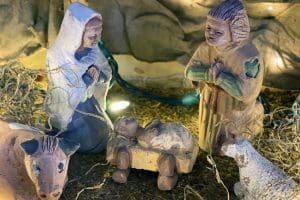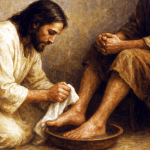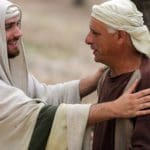What Does the Virgin Mary Have to Do with the Tree of Life?
To sign up for Meridian’s Free Newsletter, please CLICK HERE.
“Behold, the virgin whom thou seest is the mother of the Son of God, after the manner of the flesh.” (1 Nephi 11:18)
The Know
When Nephi asked the Spirit of Lord the meaning of the tree seen in his father’s dream (1 Nephi 11:11), the Spirit seemingly changed the subject, and called Nephi’s attention to “a virgin.” Nephi said that “she was exceedingly fair and white,” and “most beautiful and fair above all other virgins” (1 Nephi 11:13, 15).
As this vision proceeds, Nephi sees this woman “bearing a child in her arms” (1 Nephi 11:20), and the angel escorting him told Nephi that she is “the mother of God, after the manner of the flesh,” as found in the original text.[i] From this vision, Nephi somehow comes to understand the meaning of the tree of life (1 Nephi 11:21–22).
In 1998, Daniel C. Peterson noted a fundamental connection between the tree and virgin. The adjectives describing the virgin (“most beautiful,” “exceedingly fair,” “white”) compared to those describing the tree (“exceeding all beauty,” and “exceed[ing] the whiteness of the driven snow”), are synonyms (1 Nephi 11:8).
Just as the tree bore fruit, the virgin bore a child (1 Nephi 11:7, 20). “Clearly,” Peterson noted, “the glimpse given to Nephi of the virgin mother with her child is the answer to his question about the meaning of the tree. Indeed, it is evident that, in some sense, the virgin is the tree.”[ii]
As Peterson goes on to explain, scholars have recently come to accept that in ancient Israelite religion, there was a belief in a divine mother goddess named Asherah, who was represented by the tree of life. The symbolism is widespread throughout the ancient Near East, and can be seen in association with different goddesses by various cultures.
In 2011, Egyptologist John S. Thompson went on to explore additional connections between different Egyptian goddesses and sacred trees. Thompson notes that while most ancient Near Eastern cultures sexualized the tree goddess, the Egyptians emphasized the motherly role, often depicting tree goddesses nursing a child.[iii] The Israelite Asherah was likewise more focused on the nursing mother and less sexualized—she was the “mother of the gods” and also regarded as the mother of the Davidic kings.[iv]
The Why
Nothing is more important in Christian worship than to recognize Jesus Christ as the Son of God, born of a virgin, who became flesh as the express image of his Father (John 17:3; Hebrews 1:1–3).
The Book of Mormon, as another witness and covenant of God, testifies “that Jesus is the Christ, the Eternal God” as he “manifest[s] himself unto all nations” (Book of Mormon Title Page). The ancient abridger Mormon testified that he had written this book “for the intent that ye may believe” the Bible, and so that modern people may know of the marvelous and miraculous works that have been brought to pass “by the power of God among them” (Mormon 7:9).
The notion of a divine mother goddess strongly resonates with Latter-day Saint belief in a Heavenly Mother.[v] While Mary is not to be identified as Heavenly Mother, the ancient Israelite and Egyptian cultural backgrounds shed light on Nephi’s vision and how he made sense of imagery.
Just as Israelite and Egyptian religions associated a sacred tree with a mother of gods and kings, so did Nephi’s guide tie the idea of the tree of life together with the “mother of God, after the manner of the flesh,” whose child was the Messiah, the true Davidic King.
People everywhere can appreciate the beautiful force and effect of Nephi’s revelation. Samuel Zinner, a non-LDS scholar of Enoch studies, has remarked that the symbolism in Nephi’s vision, “implies a theological … continuity between the tree of life, Lady Jerusalem, Lady Nazareth, and the Virgin Mary. These are all ultimately specializations or refractions of Asherah.”[vi]
Margaret Barker, another non-LDS Old Testament scholar, has marveled that Nephi’s vision “is the Heavenly Mother, represented by the tree of life, and then Mary and her Son on earth. This revelation to Joseph Smith was the ancient Wisdom symbolism, intact, and almost certainly as it was known in 600 BCE.”[vii]
By Book of Mormon Central
Visit our website at https://www.bookofmormoncentral.org
Further Reading
Gospel Topics, “Mother in Heaven,” on lds.org at https://www.lds.org/topics/mother-in-heaven?lang=eng
David L. Paulsen and Martin Pulido, “‘A Mother There’: A Survey of Historical Teachings about Mother in Heaven,” BYU Studies 50, no. 1 (2011): 70–97.
Samuel Zinner, “‘Zion’ and ‘Jerusalem’ as Lady Wisdom in Moses 7 and Nephi’s Tree of Life Vision,” Interpreter: A Journal of Mormon Scripture 12 (2014): 281–323.
John S. Thompson, “The Lady at the Horizon: Egyptian Tree Goddess Iconography and Sacred Trees in Israelite Scripture and Temple Theology,” in Ancient Temple Worship: Proceedings of The Expound Symposium, 14 May 2011, ed. Matthew B. Brown, Jeffrey M. Bradshaw, Stephen D. Ricks, and John S. Thompson (Orem, Utah: Interpreter Foundation and Eborn Books, 2014), 217–241.
Daniel C. Peterson, “A Divine Mother in the Book of Mormon?” in Mormonism and the Temple: Examining an Ancient Religious Tradition, ed. Gary N. Anderson (Logan, Utah: Academy for Temple Studies and USU Religious Studies, 2013), 109–124.
Margaret Barker, “The Fragrant Tree,” in The Tree of Life: From Eden to Eternity, ed. John W. Welch and Donald W. Parry (Salt Lake City, Utah: Deseret Book and Neal A. Maxwell Institute, 2011), 55–79.
Margaret Barker, “Joseph Smith and Preexilic Israelite Religion,” in The Worlds of Joseph Smith, ed. John W. Welch (Provo, UT: Brigham Young University Press, 2005), 69–82.
Daniel C. Peterson, “Nephi and His Asherah,” Journal of Book of Mormon Studies 9, no. 2 (2000): 16–25.
Daniel C. Peterson, “Nephi and His Asherah: A Note on 1 Nephi 11:8–23,” in Mormons, Scripture, and the Ancient World: Studies in Honor of John L. Sorenson, ed. Davis Bitton (Provo, Utah: FARMS, 1998), 191–243.
[i] Royal Skousen, ed., The Book of Mormon: The Earliest Text (New Haven, CT: Yale University Press, 2009), 29.
[ii] Daniel C. Peterson, “Nephi and His Asherah: A Note on 1 Nephi 11:8–23,” in Mormons, Scripture, and the Ancient World, ed. Davis Bitton (Provo, UT: FARMS, 1998), 194.
[iii] John S. Thompson, “The Lady at the Horizon: Egyptian Tree Goddess Iconography and Sacred Trees in Israelite Scripture and Temple Theology,” in Ancient Temple Worship: Proceedings of The Expound Symposium, 14 May 2011, ed. Matthew B. Brown, Jeffrey M. Bradshaw, Stephen D. Ricks, and John S. Thompson (Orem, Utah: Interpreter Foundation and Eborn Books, 2014), 225–226.
[iv] Peterson, “Nephi and His Asherah,” 196–198.
[v] See “Mother in Heaven,” online at https://www.lds.org/topics/mother-in-heaven?lang=eng (accessed October 28, 2015).
[vi] Samuel Zinner, “‘Zion’ and ‘Jerusalem’ as Lady Wisdom in Moses 7 and Nephi’s Tree of Life Vision,” Interpreter: A Journal of Mormon Scripture 12 (2014): 313.
[vii] Margaret Barker, “Joseph Smith and Preexilic Israelite Religion,” in The Worlds of Joseph Smith, ed. John W. Welch (Provo, UT: Brigham Young University Press, 2005), 76.
The Chronicles of Mary and Joseph – Coming to Understand Mary
Part Two of Four
The earliest recorded prophecy that points to Mary and her son arises in Isaiah’s book. As he reports, he is commanded to meet Ahaz, the King of Judah, while the King and his party are inspecting “the conduit of the upper pool” on the north side of Jerusalem because this pool and its channel supply water to the temple and the city (Isaiah 7:3). The year is 534 B.C. and the city is surrounded by two hostile armies, one from Syria and one from the northern kingdom Israel.
The King and his associates are at risk while outside the city’s walls. And so are Isaiah and his son when they go to meet them. After Isaiah assures the King that the siege will soon be lifted, the prophet invites Ahaz to ask for “a sign of the Lord” to prove that the Lord will move events to this end. The King declines in an act of feigned humility that draws Isaiah’s ire (Isaiah 7:12–13). Thereupon, the prophet declares that “the Lord himself shall give you a sign; Behold, a virgin shall conceive, and bear a son, and shall call his name Immanuel.” This prophecy is fulfilled, at least in its distant future meaning, in Jesus’ birth to Mary (Isaiah 7:14; Matthew 1:22–23).
Centuries later, in Nazareth, the angel’s appearance to Mary changes everything for her. Notably, the angel’s mention of Elisabeth’s pregnancy offers a way for Mary to get away from the small town of Nazareth where everyone knows everyone else and where her promised pregnancy will soon become apparent. According to Galilean Jewish custom, pregnancy during the period of betrothal causes a scandal and can invalidate the planned marriage.
Going to Elisabeth puts Mary in the arms of the one person who knows both the challenges of silent and open criticism by one’s relatives and acquaintances as well as how to keep her head up in the face of disapproval. Mary must have gone to the home of Zacharias and Elisabeth with the approval of her parents and perhaps in the company of an older family member. Surely, she will have gone in a traveling group for safety, a necessary circumstance that Jesus’ parents enjoy years later when they travel to Jerusalem with their youthful son Jesus in a group of fellow travelers (Luke 2:44). After all, roads are dangerous for the solitary traveler (compare Luke 10:30), and the more so for a young woman.
It is in her cousin’s home that young Mary’s spiritual character becomes even more visible. For after Elisabeth speaks “with a loud voice” when welcoming her youthful cousin (Luke 1:42), Mary begins to sing. The written inspiration for Mary’s words has long been known, the prayer of Hannah (1 Samuel 2:1–10), an indicator that Mary already knows much of the Old Testament. But Mary’s song, called the Magnificat from the first word in the Latin translation, goes beyond that of Hannah who mainly celebrates God’s exaltation of the low people of the earth, an idea that includes herself and her young son Samuel.
In contrast, Mary’s song is chiefly one of redemption, both for her (“[God] that is mighty hath done to me great things”—Luke 1:49) and for others (“his mercy is on them that fear him”—Luke 1:50). The theme of redemption appears even in tiny details. For instance, Mary repeats the words “from henceforth” (Luke 1:48). These become a characteristic expression of Luke that, in most cases, points to Jesus’ redemptive act (Luke 12:52; 22:18, 69; Acts 18:6). Further, in the Septuagint the term “great things” (Luke 1:49), megala in Greek, often refers to God’s actions during the Exodus on behalf of the children of Israel, thus carrying the sense of redemption (LXX Deuteronomy 10:21; 11:7; Judges 2:7).
The trip back to Nazareth must have been emotionally taxing for Mary. After all, we have no indication that she shares the news about the angel with her family before she visits Elisabeth. On the basis of Matthew’s note, “she was found with child” (Matthew 1:18), it appears that only when she becomes visibly pregnant does she confide in Joseph. His reaction? Obviously, he does not believe her story about the angel which she must have told him to explain her condition.
His parents’ reaction? We do not know. Nor do we learn the response of Mary’s parents. Joseph’s family, naturally, has every right to demand that the betrothal be undone. This is the direction Joseph goes. Fortunately, as an honorable person, he is “not willing to make her a publick example” (Matthew 1:19). He steers Mary away from severe punishment. Then God reaches out to this good young man through His angel (Matthew 1:20–21). What the next few months are like, we are not informed. We can imagine that Joseph and Mary are happy to leave Nazareth for Bethlehem. By then, their engagement, which effectively marries them, is over and, by custom, she has been escorted to his home as many ancient manuscripts affirm by reading simply “Mary his wife” in Luke 2:5. In a word, they are married.
—Based on The Testimony of Luke by S. Kent Brown, an e-volume in the BYU New Testament Commentary Series (see byuntc.com).



















